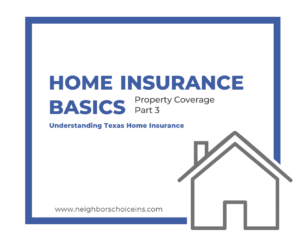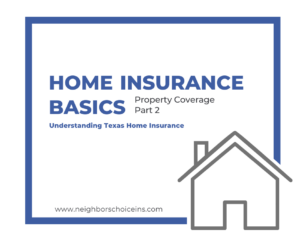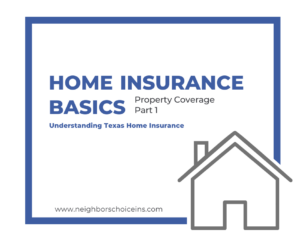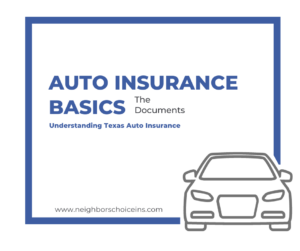In this blog, we will discuss Property Coverage Limits and Loss and of Use (Coverage D) on the Texas Home Insurance Policy. As we mentioned in Part 1 of The Basics of Property Coverage, the kind of home insurance policy we are discussing in this blog pertains only to the primary, single-family, owner-occupied residence.
Home insurance policies for condos, townhomes, rental properties, etc. are different. It is important to speak with your insurance agent about the kind of home and how it will be used in order to determine the appropriate home policy type.
Property Coverage Limits
Each category of property – Dwelling, Other Structures and Personal Property has its own limit within the Texas home insurance policy. The coverage limit is the maximum amount of money that an insurance company will pay for the specified property referenced.
Dwelling (Coverage A) – The dollar amount for Dwelling (Coverage A) shown in the Declarations is subject to a minimum amount calculated by the insurance company. Each insurance company has its own system and method of calculating the cost to rebuild the Dwelling. The insurance company takes into account the specific features of your home including, but not limited to the number of bathrooms and grade of finish (basic versus designer finishes) in the bathrooms and kitchen as well as the kind of flooring and finishes throughout the house. The insurance company wants to make sure you carry at least a certain amount of coverage on the home in case you were to experience a loss. An important note is that the amount shown on the Declarations for Dwelling (Coverage A) is not guaranteed to be enough for you to actually be able to rebuild your home in the event of a complete loss. It is important you work with your insurance agent to disclose and double check that all the features of your home are accounted for the estimated cost to rebuild.
The Dwelling (Coverage A) amount show on the Declarations is the basis for how much coverage is provided for the rest of the property coverages. The default for the Other Structures and Personal Property is a percentage of the Dwelling (Coverage A) amount.
Other Structures (Coverage B) – The Other Structures Coverage Limit is often defaulted at 10% of the Dwelling (Coverage A). That means if your Dwelling (Coverage A) limit is $500,000, the Other Structures will likely be limited to $50,000. Depending on the characteristics and features of your property, this may or may not be enough coverage in the event of a total loss.
Personal Property (Coverage C) – The Personal Property Coverage Limit is often defaulted to 50% of the Dwelling (Coverage A), but many companies may also use a default of anywhere from 40-60%. This means on a given home insurance policy with a Dwelling ( Coverage A) limit of $500,000, the Personal Property (Coverage C) amount will likely fall within the range of $200,000 to $300,000.
There are usually sub limits for personal property of certain categories under Personal Property (Coverage C). Limits vary per policy and per property category. For example, the home insurance policy often limits the amount of personal property they are willing to cover that the insured usually keeps away from the residence premises – like at a different location owned by the insured or in a storage facility.
Then there are Special Limits of Liability for certain categories of personal property. Some examples of personal property categories that are limited include (this is not a complete list): money and other forms of currency, securities, accounts, deeds, manuscripts, passports, tickets and stamps, comic books and trading cards, any kinds of collectibles, property on the residence premises used for business purposes, fine arts, trailers, watercraft and motor vehicle accessories.
In the case of theft, Special Limits of Liability are often applied to the following categories of personal property – jewelry and valuable stones, furs, silverware and trophies, firearms and related equipment, tools and accessories, rugs, tapestries, wall hangings and other similar items. The insurance policy will list out the Special Limit of Liability (how much they are willing to cover per category) separately for each category. You can usually increase these limits through a blanket or scheduled Endorsement to the insurance policy.
Loss of Use (Coverage D)
Sometimes a loss to the insured property is so substantial that the insured may not be able to live there until repairs are complete. If a Covered Loss occurs that makes the residence premises unfit to reside or live in, the insurance company will pay any necessary increase in living expenses incurred by the insured in order that they can maintain their normal standard of living. This coverage is called Loss of Use. The amount paid will be limited to the amount shown on the Declarations.
Often times Loss of Use is set at 30% of the Dwelling (Coverage A). In this case, if the Dwelling (Coverage A) limit is $500,000, the Loss of Use (Coverage D) would be limited to $150,000. There are additional conditions and time limits often set for the Loss of Use (Coverage D).
The catastrophic Texas freeze in February of 2021 caused many homeowners to be displaced from their homes due to pipes bursting. As of the writing of this blog in September 2021, we have heard that some homes have still not completed repairs (all homes with losses within our agency have had repairs completed).
When so many homeowners were displaced, there was a strain on the hotel and rental market and the already hot housing market made prices high. To compound the issue, being in the middle of the Coronavirus pandemic, there have been major supply shortages for building materials. It is taking longer and costing more for home repairs.
It is important to consider the impact of potential catastrophic events when choosing your Property Coverage Limits. In times of high demand or strain, it may not take as long as you think to exhaust your policy limits. There are additional endorsements that can be added to the home insurance policy that provide more protection in case of a loss in extenuating circumstances. We’ll address those coverage options in another blog.
Conclusion
It is important to understand the coverage limits on your insurance policy and review your coverage limits regularly. If there is any change in your property, you have the duty to inform your insurance agent or insurance company. Open communication between policyholders and their insurance agents is important to ensure that your insurance policies cover your needs as they change over time.
Disclaimer: This blog is for general informational purposes only. Please remember, for specific information about your coverage and your policy, please read your insurance policy. If there is any conflict between the information in this article and the actual terms and conditions of your policy, the terms and conditions of your policy will apply.
Contact Us!
At Neighbor’s Choice Insurance Agency, we can work with you to make sure you’ve got the insurance coverage you need, while at the same time using all possible credits and discounts to make that coverage affordable. Just give us a call at 817-421-8866 or send us a note at info@neighborschoiceins.com. We want to help you meet your goals, and make sure what’s important to you is protected!






